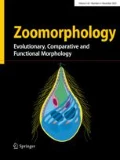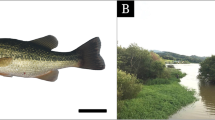Summary
The ultrastructure of the apical plate of the free-swimming pilidium larva of Lineus bilineatus (Renier 1804) is described with particular reference to the multiciliated collar cells. In the multiciliary collar cells there are several, up to 12, cilia surrounded by a collar of about 20 microvilli extending from the cells' apical surface. The cilia have the typical 9+2 axoneme arrangement and are equipped with striated caudal rootlets extending from the basal bodies. No accessary centriole or rostral rootlet were observed. Microvilli surrounding the cilia are joined in a cylindrical manner by a mucus-like substance to form a collar. In comparison with many sensory receptor cells built on a collar cell plan the multiciliary collar cells of the pilidium larva apical plate are rather simple and unspecialized. In other pilidium larvae monociliated collar cells are found in the apical plate. The possible function and phylogenetic implications of multiciliated collar cells in Nemertini are briefly discussed.
Similar content being viewed by others
Abbreviations
- a:
-
axoneme
- b:
-
basal body
- c:
-
cilia or flagella
- d:
-
desmosome
- G:
-
Golgi apparatus
- m:
-
mitochondria
- mf:
-
microfilaments
- mu:
-
mucus
- mv:
-
microvilli
- n:
-
nucleus
- nt:
-
neurotubules
- pm:
-
plasma membrane
- r:
-
rootlet
- ri:
-
ribosomes
- v:
-
secretory vesicles
References
Brill B (1973) Untersuchungen zur Ultrastruktur der Choanocyte von Ephydatia fluviatilis L. Z Zellforsch Mikrosk Anat 144:231–245
Cantell C-E (1969) Morphology, development, and biology of the pilidium larvae (Nemertini) from the Swedish West Coast. Zool Bidr Upps 38:61–112
Coe WR (1899) Development of the pilidium of certain Nemerteans. Trans Conn Acad 10:235
Dilly PN (1972) The structures of the tentacles of Rhabdopleura compacta (Hemichordata) with special reference to neurociliary control. Z Zellforsch Mikrosk Anat 129:20–39
Ehlers U, Ehlers B (1977) Monociliary receptors in interstitial Proseriata and Neorhabdocoela (Turbellaria Neoophora). Zoomorphologie 86:197–222
Ehlers U, Ehlers B (1978) Paddle cilia and discocilia — genuine structures? Cell Tissue Res 192:489–501
Feige W (1969) Die Feinstruktur der Epithelien von Ephydatia fluviatilis. Zool Jahrb Abt Anat Ontog Tiere 86:177–237
Franzén Å (1956) On spermiogenesis, morphology of the spermatozoon, and biology of fertilization among invertebrates. Zool Bidr Upps 31:355–482
Franzén Å (1982) Spermatogenesis and sperm function. Nemertini. In: Adiyodi KG (ed) Reproductive Biology of Invertebrates. Vol II. John Wiley & Sons, Ltd, New York (in press)
Hibberd DJ (1975) Observations on the ultrastructure of the choanoflagellate Codosiga botrytis (Ehr.) Saville-Kent with special reference to the flagellar apparatus. J Cell Sci 17:191–219
Knapp MF, Mill PJ (1971) The fine structure of ciliated sensory cells in the epidermis of the earthworm Lumbricus terrestris. Tissue Cell 3:623–636
Lyons KM (1973a) Collar cells in planula and adult tentacle ectoderm of the solitary coral Balanophyllia regia (Anthozoa Eupsammidae). Z Zellforsch Mikrosk Anat 145:57–74
Lyons KM (1973b) Evolutionary implications of collar cell ectoderm in a coral planula. Nature 245:50–51
Moritz K, Storch V (1971) Elektronenmikroskopische Untersuchungen eines Mechanoreceptors von Evertebraten (Priapuliden, Oligochaeten). Z Zellforsch Mikrosk Anat 117:226–234
Müller J (1847) Über einige neue Tierformen der Nordsee. Arch Anat Physiol (1847) pp 157–179
Nørrevang A, Wingstrand KG (1970) On the structure of choanocyte-like cells in some echinoderms. Acta Zool (Stockholm) 51:249–270
Rieger RM (1976) Monociliated epidermal cells in Gastrotricha: Significance for concepts of early metazoan evolution. Z Zool Syst Evolut-forsch 14:198–226
Storch V (1979) Contributions of comparative ultrastructural research to problems of invertebrate evolution. Am Zool 19:637–645
Tardent P, Schmid V (1972) Ultrastructure of mechanoreceptors of the polyp Coryne pintneri (Hydrozoa, Athecata). Exp Cell Res 72:265–275
Tyler S (1976) Comparative ultrastructure of adhesive systems in the Turbellaria. Zoomorphologie 84:1–76
Vader W, Lönning S (1975) The ultrastructure of the mesenterial filaments of the sea anemone, Bolocera tuediae. Sarsia 58:79–88
Welsch U, Storch V (1976) Comparative animal cytology and histology. Sidgwick and Jackson, London
Wilson CB (1900) The habits and early development of Cerebratulus lacteus. Q J Microsc Sci (2) 43:97–198
Woollacott RM, Zimmer RL (1971) Attachment and metamorphosis of the cheilo-ctenostome bryozoan Bugula neritina (Linné). J Morphol 134:351–382
Author information
Authors and Affiliations
Rights and permissions
About this article
Cite this article
Cantell, CE., Franzén, Å. & Sensenbaugh, T. Ultrastructure of multiciliated collar cells in the pilidium larva of Lineus bilineatus (Nemertini). Zoomorphology 101, 1–15 (1982). https://doi.org/10.1007/BF00312027
Received:
Issue Date:
DOI: https://doi.org/10.1007/BF00312027




